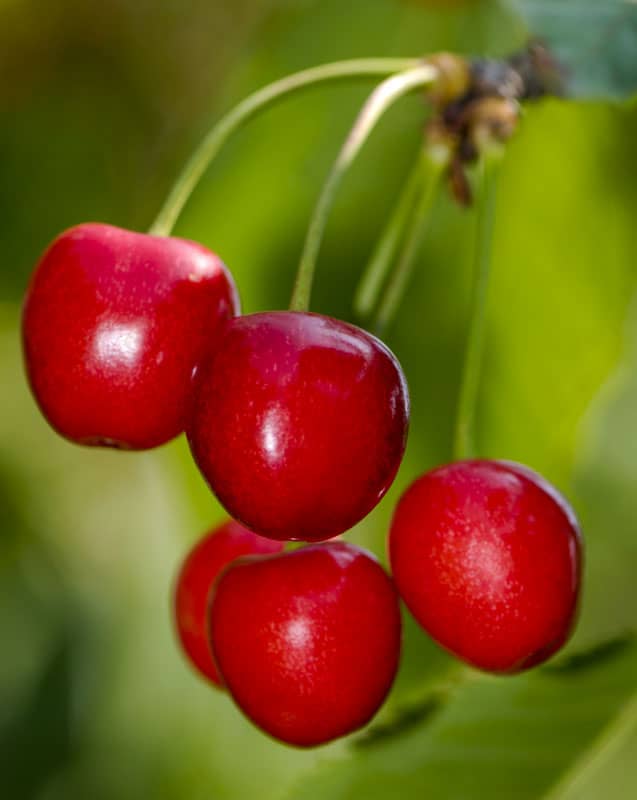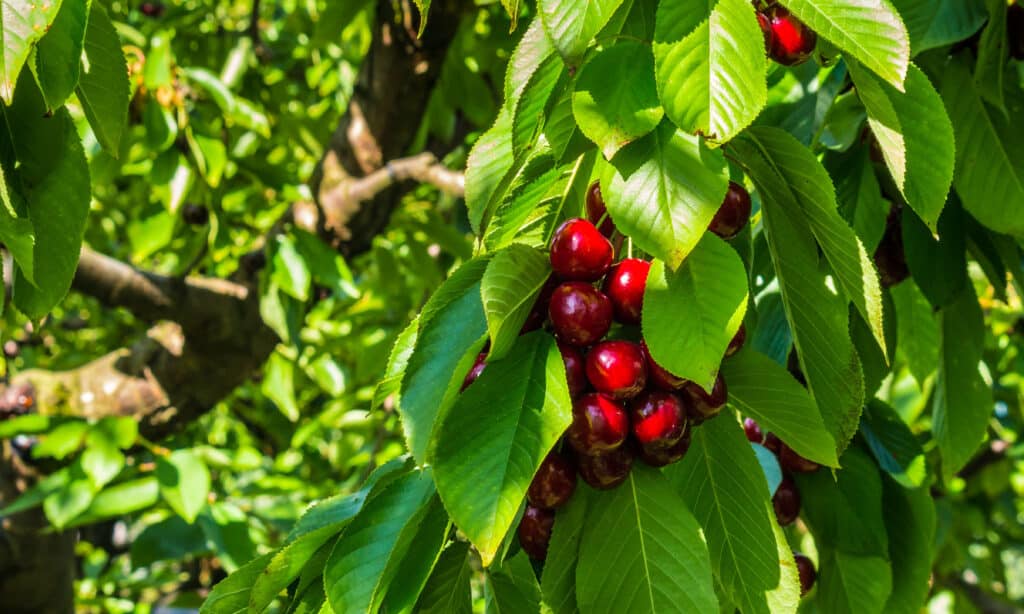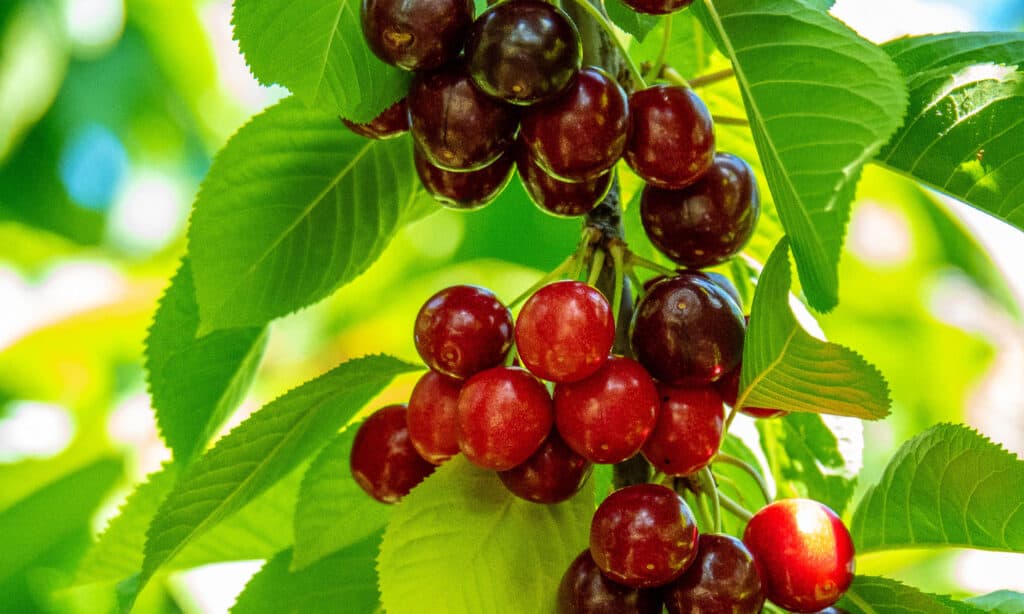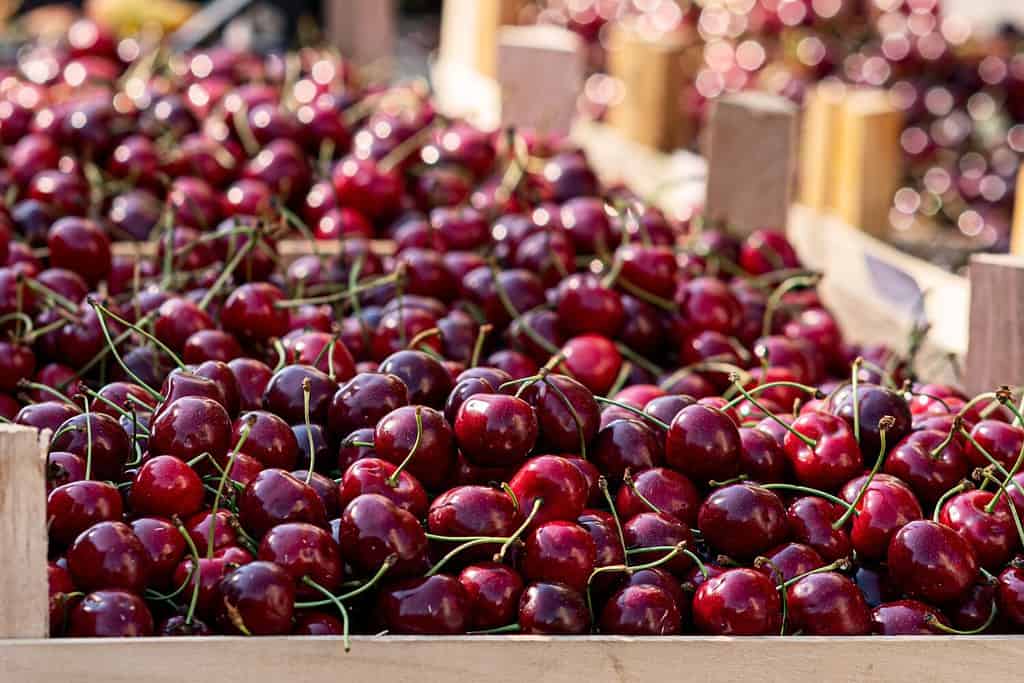Texas has a very diverse climate, with eight different growing zones across the state. What may easily sprout and blossom in one area may never fully take root in another. But its overall mild climate ensures that many fruits, vegetables, and other plants can flourish, including the cherry tree. Discover the six best cherry trees in Texas, including how to plant them and tips to help them thrive.
The Best Cherry Trees in Texas
Black Tartarian

Black Tartarian trees grow in zones 5 through 8, perfect for growing in North and Central Texas.
©alisafarov/Shutterstock.com
This cherry tree species is widespread around the country, especially in Texas. The state has hardiness zones between 6 and 10, and black cherry trees grow perfectly in zones 5 to 8. This fruit tree is an older variety, coming to America in the 1800s from Russia. It produces sweet, dark red cherries perfect for snacking or preserve making.
The Black Tartarian is excellent for home orchards, but you will need to plant a pollinator with it. This species also serves as a pollinator for other dark, sweet cherry trees. It prefers plenty of sun but is not drought tolerant, and you will need to water it during dry periods regularly. It’s an early bloomer and is ready for harvesting in June.
Royal Lee

Royal Lee trees thrive in warmer environments, making them suitable to grow in Texas.
©iStock.com/graffoto8
Royal Lee cherry trees grow in hardiness zones 7 to 10, falling within Texas’ growing zones. These dwarf trees grow successfully in lower chill areas with full sun, ripening in July. They are one of the earliest blooming sweet cherries and require pollination by the Minnie Royal.
These cherries are suited to warmer environments and produce bright red, firm, sweet fruit, perfect for eating right off the tree or used in pies and preserves. The fruit is heart-shaped, and the trees produce beautiful white blossoms. While this species does excellent in warmer climates, it will still need more water during particularly hot periods in Texas.
Nanking Cherry

The Nanking cherry tree is excellent for growing in the Texas Panhandle.
©Alex Coan/Shutterstock.com
Native to Central Asia, the Nanking cherry was introduced to North America in 1882. This fruit tree prefers cold winters and hot summers, growing in hardiness zones 3 to 7. The Nanking cherry will flourish in the Panhandle but won’t do well past Central Texas.
This tree produces fragrant white flowers in the spring and deliciously tangy, bright red fruit in mid to late summer. It has a dense branching pattern, perfect for borders, where it can bring ornamental beauty to your landscape. This species is adaptable and can thrive during periods of drought and semi-arid conditions. The fruit ripens in July and August, and many will use it to make pies, jellies, and jams.
Compact Stella

Compact Stella trees are semi-dwarf and perfect for planting in areas with limited space.
©patjo/Shutterstock.com
The Compact Stella is a semi-dwarf cherry tree and does excellent in areas with limited space. The fruit is large, dark red, firm, and sweet and goes well in baked goods or eaten straight from the tree.
This species is self-fertile and doesn’t require a pollinator; it will begin bearing fruit one to two years after planting. However, growing at least one or more stone fruit trees will allow your Compact Stella to flourish and produce even more fruit. This tree grows in zones 5 to 8 and does best in Central Texas and the Panhandle.
Sweetheart Cherry

You can harvest the Sweetheart cherry late in the season, from mid-August through September.
©PARICHUT WONGTHAI/Shutterstock.com
The Sweetheart cherry is a newer cherry variety from Canada and was introduced to the U.S. in 1990. This tree grows 7 to 10 feet high and produces pink and white blossoms with dark green leaves, which are beautiful for any garden.
This tree produces sweet and mildly tart cherries, perfect for snacking and making jam. You can harvest its fruit late in the season, from mid-August to early September. Northern Texas and the Panhandle will have an easier time growing these due to their hardiness zones of 5 through 7.
Lambert Cherry

The Lambert cherry likes colder areas and does well in Northern Texas.
©iStock.com/jura13
The Lambert cherry originated in Oregon in 1848 and is a hardy, prolific fruiter in zones 5 to 7. This species is excellent for commercial growing due to its dependability, but it also serves as a great addition to any property in Northern Texas.
The Lambert cherry is self-fertile and does not need a cross-pollinator, although it wouldn’t hurt. The deep red cherries stand in gorgeous contrast against the snow-white blossoms during summer and are ready to harvest in late June through July.
How to Plant Cherry Trees in Texas

Cherry trees prefer sandy to loamy-clay soil.
©iStock.com/RuudMorijn
Follow this step-by-step guide on how to plant cherry trees in Texas.
- Prepare your soil. Add wood chips to your soil if there is too much clay to encourage drainage and air. If not, add fresh topsoil or compost. Be sure your planting spot gets plenty of unfiltered sunlight; ensure there are now tall trees blocking your cherry tree.
- Remove the root from its container and lightly loosen them from its ball. Soak in water for one to two hours.
- Examine the root system on your tree of choice and dig a hole twice as wide and deep enough for it to fit entirely.
- Place the tree in the hole; the root system should be level with the ground. Scoop in the soil around it and gently tamp it down.
- Water the tree slowly with a trickle of water for 20 minutes. Water it on a regular schedule two to three times a week.
- Use a bit of fertilizer at the base and water it so that it soaks into the ground. The fertilizer you choose depends on your region in Texas. Ask your local garden center for the best product.
How Long Does It Take for Cherry Trees to Grow and Bear Fruit?

Full-size cherry trees can produce up to 30-50 quarts of cherries each season.
©Andrey Mihaylov/Shutterstock.com
Cherry trees require a little patience after planting as they need some time to be established and ready to bear fruit. It can take between three to five years for a cherry tree to start producing fruit. Dwarf trees are able to cultivate fruit generally a year earlier than full-size trees. Grafted cherry trees typically fruit sooner than own-root trees, at two to three years after grafting.
After they begin to bear fruit, full-size mature varieties can generate up to 30-50 quarts of cherries per year. Dwarf varieties can yield up to around 20 quarts each season.
Timing is important when harvesting. If picked too early, the fruit could be too bitter as the level of sugar increases greatly in the fruit in the days before it completely ripens and does not rise once it is picked. If picked too late, the fruit will be too soft. The best way to determine whether cherries are ripe is to taste one. A ripe cherry should be juicy and firm but have a little give.
To harvest, clip the cherries by their stems using pruning shears instead of pulling the fruit off the tree as this can damage it.
What Other Fruit Trees Grow Well in Texas?
Texas has a diverse growing climate, and some fruit trees do well in northern regions, while others flourish in warmer southern areas. These trees are suitable for growing in Texas:
- Pomegranates
- Blackberries
- Figs
- Peaches
- Pears
- Pecans
- Grapes
- Plums
- Apples.
Summary of the Best 6 Cherry Trees in Texas
Here’s a recap of the top six cherry tree types suitable for growing in the state of Texas.
| Rank | Cherry Tree | Hardiness Zones Best For |
|---|---|---|
| 1 | Black Tartarian | 5 to 8 |
| 2 | Royal Lee | 7 to 10 |
| 3 | Nanking Cherry | 3 to 7 |
| 4 | Compact Stella | 5 to 8 |
| 5 | Sweetheart Cherry | 5 to 7 |
| 6 | Lambert Cherry | 5 to 7 |
The photo featured at the top of this post is © iStock.com/RuudMorijn
Thank you for reading! Have some feedback for us? Contact the AZ Animals editorial team.






